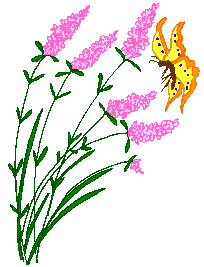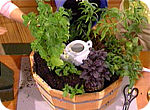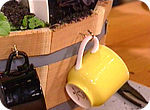|

Merry Meet,
Spring is here. I get so excited this time of year visions of my garden dance through my head as I plan my garden for this season.Its still a little early to dig in my neck of the woods so I keep myself busy planning away.
I was deciding which herbs I was going to add this year and this months topic came to me, medicinal tea gardens.Ilove herbal teas and have tried my hand at growing some chamomile, lemon balm and mint last year with wonderful results. Im planing on getting bigger and better this year adding more herbs to my tea garden.
The following articles should help you along on your way to growing a fabulous tea garden of your own wether you do a traditional garden plot or a nice container garden anyone can grow their own herbal teas.
Blessings Hazel
Homemade Tea in a Pot
Gardening expert Marianne Binetti shows how to save money by growing tea infusions. She explains how to use old, mismatched cups and saucers to avoid aggressive growth with certain teas.
Herbal Tea Garden
Materials:
cedar planter box
potting soil
clay pot
peppermint
lemon verbena
lemon balm
chamomile
grapefruit mint
saucers for tea cups
hooks
tea cups
mint plant



A cedar planter box provides plenty of space to grow several herbs. Fill around half-deep with potting soil, then invert a clay pot and place directly in the center (this will hold the center teapot).
Fill in the surrounding space with peppermint, lemon verbena, lemon balm, chamomile and grapefruit mint (figure A). Fill in the gaps with potting soil. Separate with saucers because these plants can be very aggressive (figure B).
Place hooks along the sides of the container from which to hang the tea cups (figure C). Add soil to the center tea cup, then clip a mint plant just above a node and plant it inside. This will root. Whenever a cup of herbal tea is desired, snip fresh leaves, drop them in a cup, then pour over with boiling water and allow to steep.
Guests:Marianne Binetti
Author / Gardening Expert Web site: www.binettigarden.com
Herbal Tea Garden Tips
PLANTING:
Most herbs need FULL SUN (see individual plant listings for exceptions). Herbs thrive in loose, fast-draining soil. To achieve this, amend existing garden soil with Roger's Planting Mix (1/2 and 1/2). For pots use 1/3 existing (native) garden soil mixed with 2/3 Roger's Planting Mix.
FERTILIZING:
Most herbs grow quite well with little fertilizer. We recommend using Roger's Soil Activator once a month. For perennials, start your feeding program when new foliage appears in spring. For annuals, begin feeding at planting time.
HARVEST:
Harvest herbs anytime before> the plant begins to flower, when essential oils are at their peak (except when the flowers are the type used for brewing teasee plant list).
Pick leaves in the morning after dew has dried instead of at the end of the day when the oils have been depleted by hot afternoon sunshine.
Always use sharp scissors when harvesting. Avoid crushing leaves.
DRIED HERBS:
Dried herbs have a much stronger flavor than fresh herbs. However, dried herbs DO NOT have the distinct flavor that fresh herbs contain.
Wipe off any soil or grit (avoid washing leaves unless absolutely necessary). Keep leaves out of sunlight, which extracts and evaporates essential oils.
Choose a warm, dry, dark location with adequate ventilation such as a warm loft, garden shed or garage (away from washer and dryer). 90½ F is IDEAL for the first 24 hours of drying. 75½ - 80½ F thereafter is preferable.
Hang stems of leaves in small bunches (10 stems at a time). When drying is complete, leaves should be "paper-dry" and fragile, but not so dry that they "powder" on contact.
Store in airtight, dark glass bottles away from sunlight, heat, moisture and dust.
HOW TO BREW HERBAL TEAS:
Unlike Chinese teas (Thea sinensis), herbal teas DO NOT darken as they become stronger, but remain light green or amber. Expert tea brewers gauge the strength or weakness of herbal teas by taste rather than sight.
Most teas are made from leaves, petals and flowers. For the best flavor, prepare teas by infusion pour boiling water into a teapot with herbs already inside and steep until the preferred strength is achieved. Infusion allow herbs to gently release their essential oils. If the herbs are boiled, most of the oils and flavor evaporate.
1 tsp. DRIED herbs per cup of boiling water or
3 tsp. FRESHLY PICKED herbs per cup of boiling water.
(from The Olde Farmers Almanac) |
|
|  |
|
Medicine Garden
By Marie Hofer, HGTV Ideas magazine
In the old days, it was perfectly normal for Grandma to "doctor herself" with a little something from the garden. Herbal remedies are all the rage again these days, and like Grandma, you can turn to your garden for ingredients for natural remedies--from teas to soothing baths.
When you're planning a medicine garden, make sure to shop with reputable suppliers and buy seeds or starter plants that are labeled by both genus and species, not just with a common name. Any herb or natural concoction should be used in moderation and for a limited time; natural does not automatically mean mild, and overdose is possible. Here, we tell you what plants are commonly used to treat which ailments, but you'll need professional help to learn how to harvest and process the herbs; consult a well-respected herbalist. And of course, check with your doctor before you start taking anything you grow.
Here is a collection of easy-to-grow perennials that will keep you supplied with natural remedies for years to come.
Step-by-Step
Echinacea or purple coneflower (Echinacea purpurea). The almost daisylike, rosy-purple flowers of this native woodland and prairie perennial appear atop three-foot stems from mid-summer to early fall, but medicinally they're usually just for show. Instead, it's the creeping rootstock that is popularly used to treat colds and flu. It can be put into capsules or made into a tea. E. angustifolia is considered a more potent form. Sow seeds in fall in deep, well-worked soil in a mostly sunny location.
Lavender (Lavendula angustifolia).One of the staples of medicine chests for the last few thousand years, the fading flowers are used in a wide range of remedies for anxiety, headaches, insomnia, menopausal symptoms and wounds. They're also prized for their relaxing scent. Sow seeds in a sunny location (or use starter plants). Lavender prefers neutral to alkaline soil; sweeten your soil with a little lime if it's too acid. The plant quickly becomes woody; prune in spring and again lightly after bloom.
St. John's wort (Hypericum perforatum). If the small, bright yellow summer flowers of this tufted perennial don't cheer you up, then its ingredients certainly will. The tiny "holes" in the leaves are actually colorless pockets of essential oils. Many species of St. John's wort exist, but only this one is widely used as an antidepressant. Foliage, flowers and stems go into making the infusion, and the flowers can also be used as an antiseptic topical treatment for minor scrapes and cuts. St. John's wort is an extremely adaptable plant for almost any pH or soil type, performing especially well in dry, rocky sites. Sow seeds or put in bare-root plants in fall, allowing two feet between plants.
Lemon balm (Melissa officinalis). The leaves are used in massage oils and as a balm for insect bites and also as an ingredient for a calming tea for colds flu, nervousness and depression. Sow seeds in fall. Lemon balm is not picky as to soil and grows equally well in sun or partial shade. Once it gets going, this herb wants to take over, self-seeding with abandon and also creeping by woody rootstock. Yellow and creamy-white variegations are available.
Meadowsweet (Filipendula ulmaria). More than 150 years ago the flowers, leaves and stems of meadowsweet were discovered to hold salicylates, the mainstay of aspirin. But unlike aspirin, this rhizomatous perennial is also thought to soothe indigestion. A member of a family of stream-bank dwellers, meadowsweet needs moist soil in sunny locations. The creamy-white flower clusters appear on branching stems up to three feet tall in summer. Double flower and variegated forms are also available. Sow seeds in early spring or divide roots in spring or fall.
German chamomile (Matricaria recutita) or Roman chamomile (Chamaemelum nobile). Not just a soothing bedtime drink, steam inhalation of chamomile flowers is said to help soothe hay fever, a poultice can revive tired eyes, and, like lavender, chamomile is great in a hot bath. Although not a perennial, chamomile gives itself to self-seeding with abandon, and you'll find yourself with more volunteers than you'll know what to do with. Give it well-drained, slightly acid soil and full sun. Herbal Teas
To make a soothing herbal tea, use 1 tablespoon of fresh herbs per cup of hot water. Snip some herbs into a small teapot and add hot, not boiling, water. (If the water is too hot, you'll burn off the herb's volatile oils, which create the flavor.) Allow the tea to steep for five minutes or less; if you steep the tea too long, flavors may become bitter. Strain the tea into a cup, and enjoy.
Dried herbs that work well for teas, hot or iced:
chamomile flowers
fennel
lavender
lemon balm
lemongrass
lemon verbena
nettles
peppermint
raspberry leaf
red clover
rose hips
spearmint
A Tea Tip: Instead of throwing away leftover tea, use it to water your houseplants. Plants like tea as long as it's caffeine-free.


|
 |
|
|




